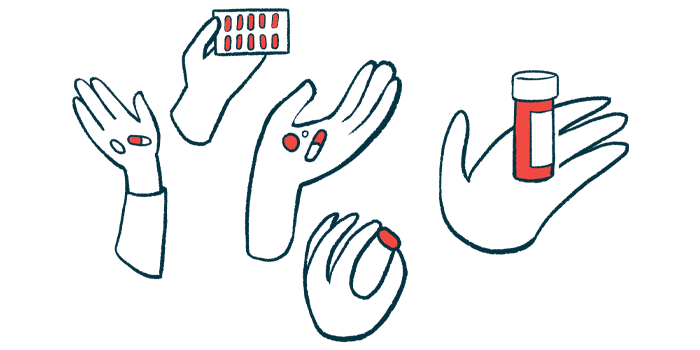Crushed Ingrezza likely effective if added to soft foods, feeding tube: Study
Potential way of treating patients with chorea, unable to easily swallow capsules

The contents of Ingrezza (valbenazine) can be taken from their capsules and crushed before being sprinkled on soft foods or given via a feeding tube to Huntington’s disease patients who have difficulty swallowing whole capsules, a preclinical study showed.
A Neurocrine Biosciences’ oral therapy, Ingrezza was approved in the U.S. this year in the form of capsules to be swallowed whole by adults with Huntington’s-associated chorea, characterized by involuntary, jerky movements.
Researchers at Neurocrine and other institutes demonstrated that Ingrezza’s active ingredient, valbenazine, was released at sufficient levels when the capsules’ contents were crushed and sprinkled on soft foods, or dissolved in water for feeding tube administration.
“These results suggest that the crushed contents of Ingrezza, which is currently administered as one capsule, once daily, can be added to soft foods or liquids or mixed with water and delivered via a gastronomy tube,” Eiry W. Roberts, MD, chief medical officer at Neurocrine, said in an emailed statement to Huntington’s Disease News.
Ingrezza is an approved, daily oral therapy for chorea in Huntington’s patients
“The data are promising for adults living with chorea associated with Huntington’s disease, many of whom may have difficulty swallowing whole capsules,” Roberts said.
An application currently is under U.S. Food and Drug Administration review for a granulated form of Ingrezza that’s meant to be opened and sprinkled on food, and a decision is expected in April. Neurocrine reported that this formulation showed similar safety and efficacy profiles to the whole capsules.
The Neurocrine-sponsored study, “Crushing the Contents of Valbenazine Capsules for Potential Addition to Soft Foods or Administration via Gastrostomy Tube,” was published in Clinical Therapeutics.
Chorea, a troublesome symptom observed in about 90% of all Huntington’s patients, is thought to be associated with unusually higher levels of a brain signaling molecule called dopamine.
Ingrezza is a small molecule that suppresses the VMAT2 protein, which is responsible for transporting and recycling dopamine at nerve cell junctions. Treatment eased the severity of chorea in a Phase 3 trial, with the therapy’s effects thought to be associated with its ability reduce the amount of dopamine released by nerve cells at their junctions.
Taken as a single capsule at 40, 60, or 80 mg once daily with or without food, Ingrezza also is approved to treat adults with tardive dyskinesia, another movement disorder.
But dysphagia, or swallowing difficulties, are common in people with Huntington’s disease and other movement disorders, which can make swallowing these capsules difficult.
Patients with these problems, as well as their medical staff, often crush pills or open oral capsules to add to soft foods or a feeding tube, although there’s not always data supporting “the acceptability of their alternative administration methods in terms of tolerability and optimal dose delivery,” the researchers wrote.
A “logical next step” would be investigating such ways of delivering Ingrezza to these patients, they added.
Acceptable release of medication seen in liquids and various soft foods
The scientists conducted three lab studies into the feasibility of crushing Ingrezza for use with soft foods or in a feeding tube, also called a G-tube.
First, a whole Ingrezza capsule (40 or 80 mg) and the crushed contents of an opened capsule were placed in a hot liquid and the release of valbenazine into the liquid measured.
Regardless of whether the capsules were intact or their contents crushed, valbenazine dissolution into the fluid — known as recovery — was reported to be rapid and complete, with more than 98% of a capsule’s valbenazine released after 15 minutes.
When crushed Ingrezza was sprinkled onto soft foods with a range of different acidity levels, including sugar-free applesauce, low-carb vanilla yogurt, and chocolate pudding, a valbenazine recovery of 91.6% to 99.9% was observed within two hours.
Likewise, when crushed tablets were mixed into a fluid designed to mimic the stomach environment, the medication was acceptably released.
“On the basis of pH and common use, administration of [Ingrezza] may be acceptable in additional … soft foods, such as cottage cheese, hummus, and jelly/jam; mashed foods, such as bananas, apricots, blueberries, mangoes, … sweet potatoes, and potatoes (red, Russet, or Yukon Gold); and liquids, such as orange juice and cranberry juice,” the team wrote.
Finally, Ingrezza’s crushed contents showed a 91%-97% recovery when dissolved in cold, room temperature, or hot water, and then injected into a feeding tube. Valbenazine also was stable when mixed with water and stored at room temperature for 2.5 hours, the scientists reported.
“Data from studies conducted in controlled laboratory settings suggest that the crushed contents from [Ingrezza] capsules may be added to soft foods or liquids, including those that are acidic, or mixed with water and delivered via G-tube,” they wrote.
While pharmacological studies in people are needed to confirm their findings, these data are “promising for patients who have difficulty swallowing whole [Ingrezza] capsules, as well as for health care practitioners who administer medications to these patients at home or in long-term care settings,” the researchers concluded.






